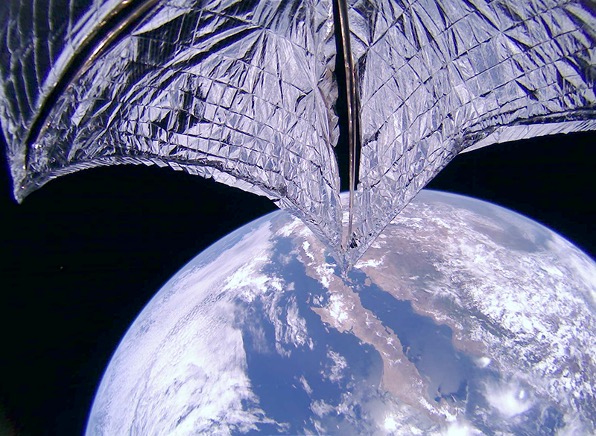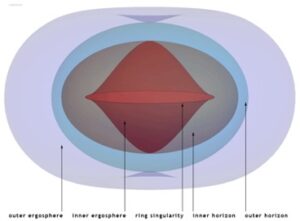
Figure 1: This is an image of LightSail 2, launched June 25, 2019, which solely utilizes sunlight to propel its orbit. This is a revolutionary example of “light sailing,” in which a reflective material is used to extract the energy of light particles in order to propel a spacecraft. Recently, scientists have suggested using a similar method to propel spacecraft all the way to other star systems.
Source: Wikimedia Commons
Rockets powered by combustion are currently the leading form of space transport. They have taken large satellites into orbit around the Earth and have even transported man to the moon. Although the accomplishments are vast, these types of rockets are actually incredibly slow. For example, it would take NASA’s Voyager 1 spacecraft, which launched in 1977 and reached interstellar space in 2012, about 75,000 years to reach Alpha Centauri – the closest star system to Earth at around 4.37 light years (25.6 trillion miles) away. This deficiency stems from the fact that conventional rockets are so massive. Longer trips require more propellant, which adds more mass, which requires even more propellant, and so on.1
Recent research has begun to support the suggestion that “light sailing” is the most feasible option for space travel.1 Light sailing works by capturing the energy of photons, the particles of light, that penetrate the sail’s built-in reflective sheet. Each photon carries momentum that is imparted onto the reflective sheet, and as billions of particles hit the mirror, the sail is propelled to rapid speeds.3 The $100 million Breakthrough Starshot initiative, announced in 2016, strives to launch swarms of microchip-sized spacecraft sporting extremely thin and flexible light sails to Alpha Centauri. The blueprint predicts that these spacecraft will travel up to 20% the speed of light, which means they would reach the star system in 20 years as opposed to the thousands of years required by conventional rockets. The issue with this project is the need for an incredibly powerful ground-based laser array, which does not yet exist and would cost around $5 to 10 million to make.1
In a new study, astrophysicists suggested that a similar, and cheaper, option could be employed that involves ultralight bubbles made of carbon foam. Probes made of this material could make interstellar journeys faster using solely sunlight (thereby abolishing the need for the ground-based laser array). Utilizing previous research, the scientists looked for a strong and lightweight material. They settled on aerographite, a carbon-based foam that is 15,000 times lighter than aluminum. They calculated that a hollow aerographite sphere one meter in diameter with a one micron thick shell (for comparison, red blood cells are 6-8 microns across) would weigh only five millionths of a pound.1,2 The scientists also calculated that if such a sphere carrying one gram of material were released 0.04 astronomical units (one astronomical unit is the average distance of the Earth from the Sun) from the sun, sunlight would propel it to a speed of about 15.4 million mph. That sphere could reach the closest star in Alpha Centauri, Proxima Centauri, in only 185 years – not quite as fast as the proposed 20 years with the laser array, but still well above the current speed. Furthermore, the scientists estimated that a prototype bubble craft would cost $1 million, but that after the prototype is developed each real craft would then cost only $1,000 or less. That being said, no person has ever built an aerographite structure larger than a few centimeters, while the size of the proposed structure is on the order of meters. Another point of caution is that the scientists have not yet figured out how to control the trajectory of the spheres once they are launched.1
Although the scientists are still seeking to correct their design’s imperfections, they have already detailed a number of the craft’s exciting implications. The scientists suggested that the craft could potentially carry a 32-watt laser weighing only one gram. This laser could help detect gravitational effects, which could reveal the presence of other worlds too dark to spot by telescope. This laser may even be capable of detecting “Planet Nine,” the hypothetical Neptune-sized object that could explain the peculiar orbits of some objects in the Kuiper Belt.1,4 Furthermore, while existing rockets have only taken man to the moon, utilizing this design could help innovate a spacecraft that would allow humans to travel to other star systems within a single lifetime. If more studies are put into this design and if more innovations are created as a result of it, space exploration could be greatly enhanced.1
References
- Choi, C. (2020, August 27). Could Carbon-Foam Probes Sail to Nearby Stars? Scientific American. Retrieved September 5, 2020 from https://www.scientificamerican.com/article/could-carbon-foam-probes-sail-to-nearby-stars/
- McAlpine, J. (2020, February 7). How Big is a Micron? Benchmark. Retrieved September 5, 2020 from https://www.bench.com/setting-the-benchmark/how-big-is-a-micron
- Fox, S. (2010, May 17). How Do Solar Sails Work? LiveScience. Retrieved September 5, 2020 from https://www.livescience.com/32593-how-do-solar-sails-work-.html
- Barnett, A. (2019, December 19). Hypothetical Planet X. NASA Science. Retrieved September 13, 2020 from https://solarsystem.nasa.gov/planets/hypothetical-planet-x/in-depth/
- Choi, C. (2020, August 24). Could carbon-foam robes bring interstellar flight within reach. Space.com. Retrieved September 5, 2020 from https://www.space.com/interstellar-spacecraft-carbon-foam-alpha-centauri.html
Related Posts
Magnetic Reconnection Offers New Insight into Harnessing Energy from Black Holes
Figure 1: Basic architecture of a rotating black hole. In...
Read MoreQuantum Entanglement and Specific Qubit Segmentation in Computing and Sensory Technology
Cover Image: This image illustrates a qubit’s (quantum bit) generic...
Read MoreSai Rayasam



